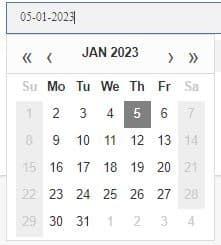Have you had a scenario where the sample date you entered doesn’t match what is on the final report? And are you confident you didn’t make a typo? You’re in luck. Here we are going to explain why this might be happening to you.
Best Practice
The first thing to explain is how it is best practice to register samples. Ideally, you should pre-register on the same day you take the sample and press send to lab at the end of the batch. That way there is very little that can go wrong as everything is autocompleted for you and that is the way the system is designed. We keep track of both the sample date and pre-registered date and should there be an issue we always have your pre-registered date to refer to, which is set in stone.
However, we do realise not everyone works this way. If you often wait to rack up a large batch of samples all taken on different days over weeks or months to pre-register or you forget to press send to lab before posting off your sample you can experience issues with the sample date. Not to worry though, it just helps to explain how the system works so you don’t fall into the common pitfalls.
How is the date stored?
All dates in the majority of coding languages are stored in the USA format of Month-Day-Year. Even if you type in a date into outlook or any programme in the British Day-Month-Year format it has to be converted to the American format in every computer system in the world. This is then stored as the number of seconds since January 1st, 1970 at 00:00:00 UTC, which is a weird and wonderful quirk of the original computing systems.
So what can go wrong with storing dates – GOLDEN RULE – ALWAYS USE THE DATE PICKER.
You will notice on the website as do most computers use date pickers, where you click in the box and use the < and > to change the month and the << and >> to change the year and then click on the day to finish. This may seem strange, but there has been a push by many tech companies to move to year – month – day as a standard format, which these date pickers are better adapted to handling. All this may seem confusing, and indeed it is as the way a date can be stored has many combinations. Hence, why there is one golden rule when using the portal. NEVER EVER type the date, always use the date picker. If I change the 05 to 01, I could be changing the month field, so it is always best practice to use the date picker which will update the code to the way the date is eventually held which is the American format. 90% of problems come from people typing the date instead.
Why does this matter? Well, the 5th of January and the 1st of May are very different dates but it is only a matter of how the data is stored. So typing a date rather than using the date picker risks these being the wrong way round. So as a golden rule, use the date picker even if it take a couple seconds longer.
Batch issues with dates – The date applies to the WHOLE batch in your queue
Certain fields such as sample date and job number apply to a batch of samples (i.e. the samples in your queue), so if for instance, you change the date on 1 of the 10 samples you are registering, then the whole batch will use the same sample date as sample date applies to the batch you are doing. Hence, if you have batches of samples with different sample dates, press send to lab between each change in sample date to avoid problems.
Leaving your queue to send later – a disaster waiting to happen. Always remember to press send to lab before leaving the portal.
If you forget to press send to lab not only will your samples likely be delayed but the date can be wrong too. This is because the sample date applies to your whole batch. So if for instance you did 1 sample on the 5th of January and another 10 on the 26th of January, and didn’t press send to lab on your first batch, the samples from both batches will all have the same sample date as the date applies to the entire queue. If you wait until the day after the lab receive then you will have a negative difference between sample date and received date, which can’t be right.
What do the lab do if they suspect a date is wrong?
We try to accommodate for customer errors as much as possible. For example, if we see a sample date is from 12 months ago, then we may change the year to match the current year, or if a sample was only pre-registered a week ago, but the sample date says it was taken 9 months ago we may change the date to the pre-reg date instead. We also look at your sampling frequency too, so if you sample every month and you have a sample with a date of 4 months ago, we will adjust accordingly. We try our best to catch these things for customers, but we are not mind readers. Sometimes, the date may be correct and you have waited 6 months to record the sample on the system. At this point, it may be worth asking what is the relevance of such an old sample, and perhaps taking a current sample may be more helpful.
Enough explaining…how do i change the date?
If you need to change a date on the portal this can be done fairly easily using this guide. However, hopefully the guide above will help you to avoid the issue going forward.


